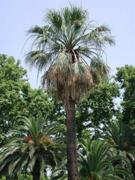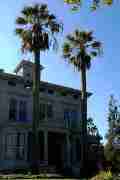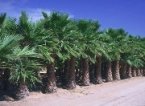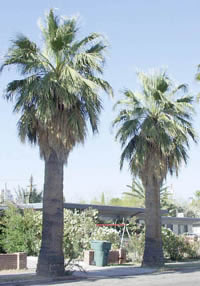California Fan Palm Trees (Washingtonia filifera)

The Cold hardy California Fan Palm Tree:
- Can grow up to 60' with a crown spread of
15'
- Can have up to thirty gray-green palmate
(fan-shaped) leaves, each 3-6' across
- Have leaves that spread out to form a loose
and open crown
- Young Washington Palms need plenty of sun
- Palm will tolerate soils and drought
- Have a moderate growth rate
California Fan Palm Overview
Stately and distinctive,
the California Fan Palm tree is one of the most
widely grown palms in subtropical climates. The
California Fan palms massive gray trunks are barrel shaped and ringed with
old leaf scars, and may reach over 3' in diameter
at the Palms widest point. The petioles (leaf stems) of
mature palms are armed along the margins with curved
thorns; those of young palms are largely unarmed.
The individual leaflets are pendulous and swing
freely in the wind. Abundant cotton-like threads
on and between the leaflets persist even when the
California Palm tree is mature. If old leaves are not removed, they
form a continuous "petticoat" from the crown all
the way to the ground. The California Fan Palm tree
produces numerous branching flower clusters that
project out and often downward from the leaf crown.
The bisexual blossoms are white and yellow and give
rise to oblong or round red-black fruit, each about
a half inch in diameter. The fruits of California
Fan Palm trees contain a single seed, approximately 1/4"
in diameter.
California Fan Palm (Washingtonia filifera) Information
Scientific name: Washingtonia filifera
Pronunciation: wosh-ing-TOE-nee-uh fill-LIFF-er-uh
Common name(s): Desert Palm, California Washingtonia Palm
Family: Arecaceae
USDA hardiness zones: 8+
Origin: not native to North America
Invasive potential: little invasive potential
Uses: street without sidewalk; tree lawn 3-4 feet wide; tree lawn 4-6 feet wide; tree lawn > 6 ft wide
Availability: not native to North America
California Fan Palm Description
Height: 40 to 60 feet
Spread: 10 to 15 feet
Crown uniformity: symmetrical
Crown shape: palm, upright/erect
Crown density: open
Growth rate: moderate
Texture: coarse
California Fan Foliage
Leaf arrangement: alternate
Leaf type: costapalmate
Leaf margin: entire
Leaf shape: star-shaped
Leaf venation: palmate
Leaf type and persistence: evergreen, broadleaf evergreen
Leaf blade length: more than 36 inches
Leaf color: green
Fall color: no color change
Fall characteristic: not showy
California Fan Palm Tree Flower
Flower color: yellow, white/cream/gray
Flower characteristics: not showy
The Palm Fruit
Fruit shape: oval, round
Fruit length: less than .5 inch
Fruit covering: fleshy
Fruit color: black
Fruit characteristics: does not attract wildlife; not showy; fruit/leaves not a litter problem
California Fan Palm Trees Trunk and Branches
Trunk/bark/branches: branches don't droop; not showy; typically one trunk; thorns
Pruning requirement: needed for strong structure
Breakage: resistant
Current year twig color: not applicable
Current year twig thickness:
Wood specific gravity: unknown
California Fan Palms Culture
Light requirement: full sun
Soil tolerances: clay; sand; loam; acidic; alkaline; well-drained
Drought tolerance: high
Aerosol salt tolerance: moderate
Other
Roots: not a problem
Winter interest: no
Outstanding tree: no
Ozone sensitivity: unknown
Verticillium wilt susceptibility: resistant
Pest resistance: resistant to pests/diseases
California Fan Palm Tree Use and Management
The lower leaves persist on the tree after they die, forming a dense, brown, shaggy covering below the living, grey/green, broad, fan-shaped leaves, giving it the common name of Petticoat Palm. These dead fronds are known to be a fire hazard and a popular bedding roost for rodents and, because of this, must be removed by law in some areas.
Plant this palm only on soil which is extremely well-drained to prevent trunk or root rot. Moderate salt tolerance allows it to be used close to the coast in several of the southern states. This palm could be tried more in well-drained sites as a replacement for Washingtonia robusta which grows very tall with a skinny trunk. But over-irrigation and rainy weather could initiate root rot. Washingtonia filifera is shorter, has a thicker trunk, and is better suited for planting in dry urban landscapes, such as in Texas, Arizona and California. They reportedly suffer and often die from root rot when irrigated. Select Washingtonia robusta in an irrigated landscape and for the eastern U.S.
Propagation is by seed.
California Palms Pests
Pests
Scales while young, palm weevil in old age, palm leaf skeletonizer and a variety of scales at any time can infest this palm.
Diseases
California Palm Tree Disease
Trunk or root rot in wet soils may infect this tree. |

California Fan Palm - Large Palm Tree
From: Real Palm Trees





Other Cold Hardy Palms you might be interested in:
True Date Palms (Phoenix dactylifera)
(Sabal mexicana)
(Butia capitata)
(Cycas revoluta)
Queen Palm
(Syagrus romanzoffiana)
Date Palm
(Phoenix dactylifera)


|













